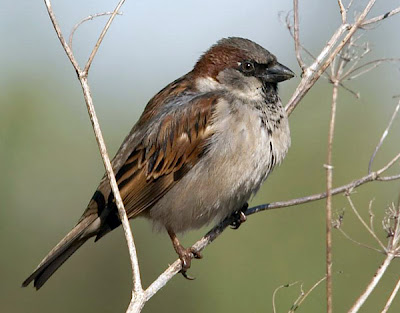The house sparrow is probably the most familiar of British birds and is largely dependent on the food and nesting places found in gardens.
 Characteristics
Characteristics
The male House Sparrow has a grey crown, cheeks and underparts, black on the throat, upper breast and between the bill and eyes. The bill in summer is blue-black, and the legs are brown. In winter the plumage is dulled by pale edgings and the bill is yellowish brown. The female has no black on head or throat, nor a grey crown; her upperparts are streaked with brown. The juveniles are deeper brown, and the white is replaced by buff; the beak is dull yellow.
 Habitat
Habitat
Found from the centre of cities to the farmland of the countryside, it feeds and breeds near to people. Where there are no suitable man-made structures the House Sparrow will build a domed nest in a hedge, bush or tree.
 Behaviour
Behaviour
Although the Sparrows’ young are fed on the larvae of insects, the House Sparrows eat seeds, including grain where it is available. In spring, flowers, especially those with yellow colours, are often eaten; crocuses, primroses and aconites seem to attract the house sparrow most. The bird will also hunt butterflies.
 The Sparrow’s most common call is a short and incessant chirp. It also has a double call note ‘phillip’. While the young are in their nests, the older birds utter a long ‘churr’.
The Sparrow’s most common call is a short and incessant chirp. It also has a double call note ‘phillip’. While the young are in their nests, the older birds utter a long ‘churr’.
B.A.C.









